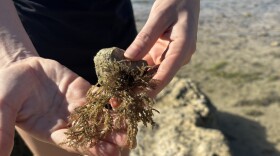A newly discovered species of red algae has been spreading quickly in Papahānaumokuākea Marine National Monument.
The National Oceanic and Atmospheric Administration is monitoring the algae known as Chondria tumulosa. The species was first identified in 2020. It suffocates native coral by cutting off their water flow and light.
The algae is labeled as a nuisance, rather than an invasive species, because it has only been identified in Papahānaumokuākea near Kuaihelani (Midway Atoll) and Manawai (Pearl & Hermes Atoll).
A species cannot be labeled as invasive if it originated in Hawaiʻi.
But Cooperative Institute for Marine and Atmospheric Research's resource protection manager Brian Hauk speculates the algae likely came from somewhere else.
"I think this algae probably got introduced by some kind of floating debris that came in from a temperate part of the world," he told HPR.
"This algae has the ability to grow down to depths of about 20 meters, and it can grow on the underside of substrates you know in dark and changes pigmentation that does quite well in low light conditions. Also, the results of some of our freezer lethality trials suggests that the species has quite a tolerance range for lower temperatures," Hauk said.
During a 17-day research mission in July, Hauk and a team of NOAA researchers saw native surgeonfish taking a bite out of the Chondria tumulosa and spitting it out. The fish proceeded to consume native algae growing nearby.
The algae covered 30% of the inspected survey sites. Manawai suffers more coverage than Kuaihelani.
NOAA is trying to develop a management plan to prevent further spread of the algae.




